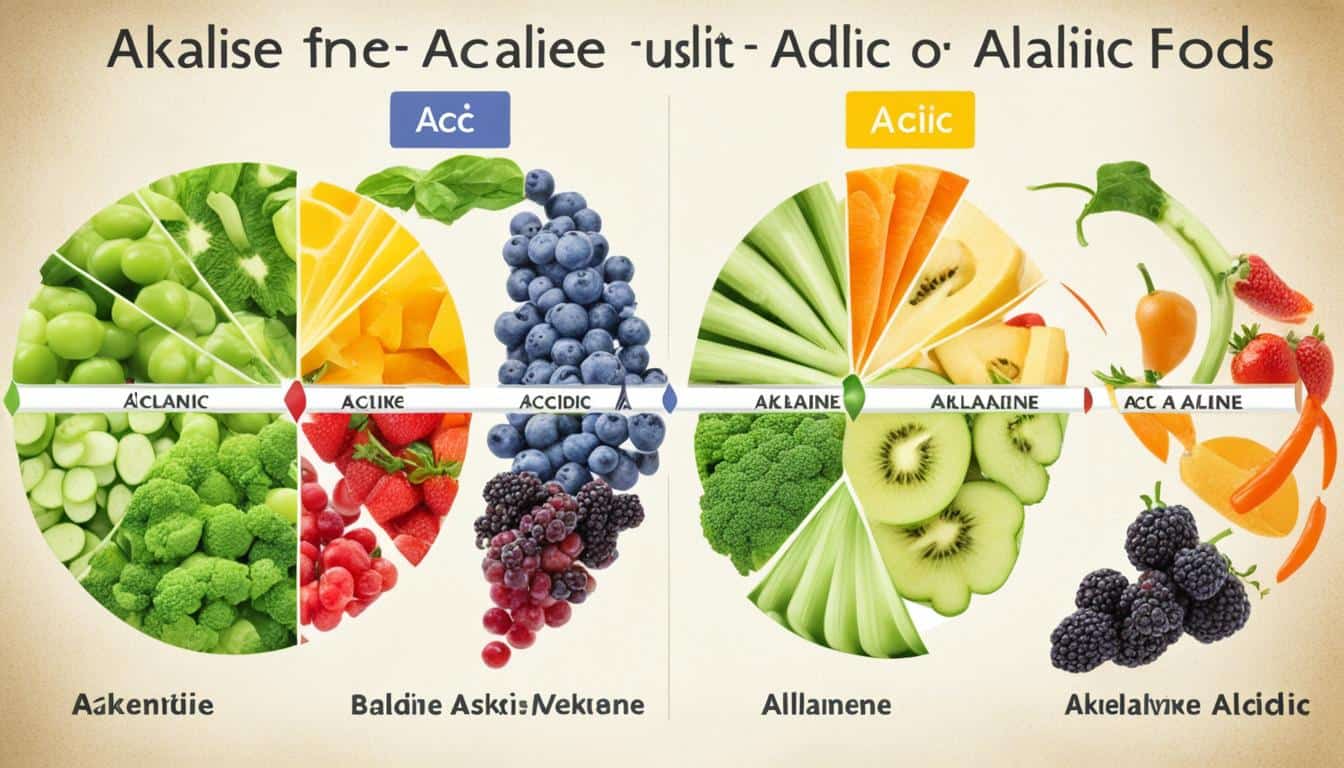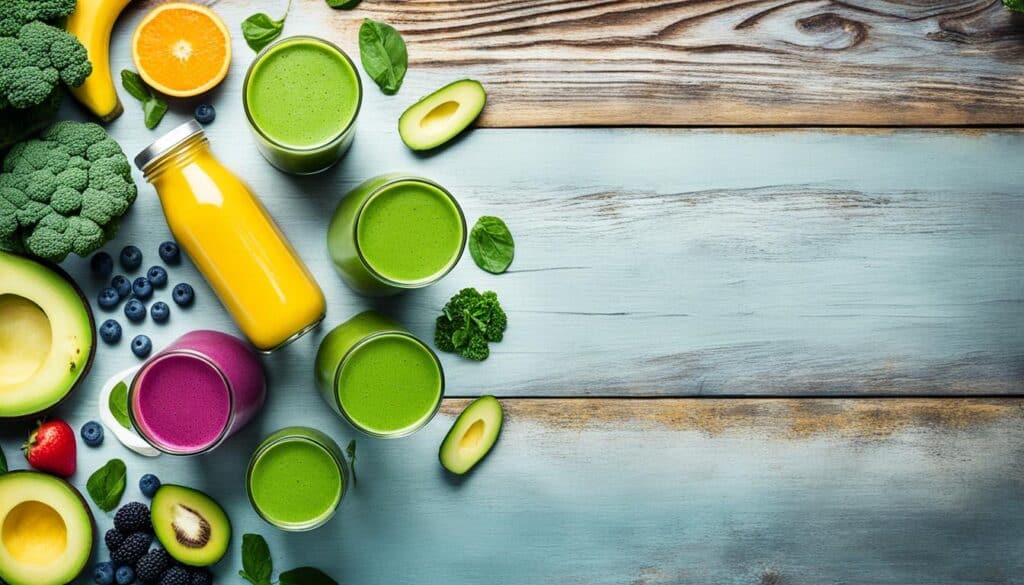Did you know that including alkaline fruits and vegetables in your diet can have a significant impact on your overall health? These alkaline foods can help regulate metabolic acid in the body, protect against inflammation, and prevent conditions like diabetes, high blood pressure, and cancer.
While the pH of a food may be acidic, it can still have an alkaline effect in the body. Fruits like avocados, oranges, grapes, watermelon, and apples, as well as vegetables like asparagus, lettuce, tomato, garlic, cauliflower, and spinach, are considered alkaline foods.
Including these alkaline fruits and veggies in your daily meals can promote good health and improve your well-being. Are you ready to take a closer look at the benefits of the alkaline diet and explore some delicious ways to incorporate these foods into your meals?
Key Takeaways:
- Alkaline fruits and vegetables can help regulate metabolic acid in the body.
- Including alkaline foods in your diet can protect against inflammation and prevent conditions like diabetes, high blood pressure, and cancer.
- Fruits like avocados, oranges, grapes, watermelon, and apples, as well as vegetables like asparagus, lettuce, tomato, garlic, cauliflower, and spinach, are considered alkaline foods.
Types of Alkaline Foods
When it comes to maintaining a healthy pH balance in the body, incorporating alkaline foods into your diet is key. Alkaline foods are known for their ability to regulate metabolic acid and promote overall well-being. The most common types of alkaline foods include fruits, vegetables, herbs and spices, and natural fats.
Fruits
- Avocados
- Oranges
- Grapes
- Watermelon
- Apples
These fruits are not only delicious but also rich in fiber and antioxidants, making them excellent choices for maintaining a healthy pH balance in the body.
Vegetables
- Asparagus
- Lettuce
- Tomato
- Garlic
- Cauliflower
- Spinach
Vegetables such as asparagus, lettuce, tomato, garlic, cauliflower, and spinach are alkaline foods that can help prevent health conditions like diabetes. Including these vegetables in your diet provides essential nutrients while promoting pH regulation.
Herbs and Spices
- Turmeric
- Cinnamon
- Pepper
- Ginger
Herbs and spices like turmeric, cinnamon, pepper, and ginger are not only flavorful additions to your meals but also rich in antioxidants and minerals. These ingredients contribute to regulating metabolic acid in the body.
Natural Fats
- Walnuts
- Chestnuts
- Flaxseeds
- Pumpkin Seeds
- Extra Virgin Olive Oil
Natural fats found in walnuts, chestnuts, flaxseeds, pumpkin seeds, and extra virgin olive oil can help neutralize or reduce the production of acid in the body. Including these healthy fats in your diet can contribute to maintaining a proper pH balance.
By incorporating these types of alkaline foods into your meals, you can enjoy a variety of flavors while promoting a healthy pH balance in your body.
Image:
Difference between Alkaline and Acidic Foods
When it comes to our diet, understanding the difference between alkaline and acidic foods is key to maintaining optimal health. Acidic foods, such as legumes, cheese, meat, fish, eggs, and processed foods, can increase acidic waste in the body, leading to oxidative stress and conditions like cancer and hypertension. On the other hand, alkaline foods can help maintain pH balance and prevent these health issues. It’s important to note that the pH of a food does not always determine its alkalinity or acidity in the body, as the digestion process can neutralize acidity.
Let’s take a closer look at the effects of alkaline and acidic foods on our bodies:
Alkaline Foods
Alkaline foods have a pH level higher than 7 and can help balance our body’s pH level. These foods are typically rich in essential nutrients and antioxidants that promote good health. Some examples of alkaline foods include:
- Leafy green vegetables like spinach and kale
- Fruits such as apples, oranges, and berries
- Nuts and seeds like almonds and chia seeds
- Herbs and spices like turmeric and ginger
- Healthy fats like avocado and olive oil
Including alkaline foods in our diet can have numerous benefits, including improved digestion, increased energy levels, and reduced inflammation.
Acidic Foods
On the other hand, acidic foods have a pH level lower than 7 and can contribute to an acidic environment in our bodies. These foods are often high in saturated fats, refined sugars, and preservatives. Some examples of acidic foods include:
- Processed meats like bacon and sausages
- Dairy products such as cheese and yogurt
- Refined grains like white bread and pasta
- Sweets and carbonated beverages
Consuming excessive amounts of acidic foods can lead to health issues such as inflammation, digestive problems, and weakened immune function.
It’s important to strike a balance between alkaline and acidic foods in our diet. While it’s almost impossible to completely eliminate acidic foods, we can make conscious choices to include more alkaline foods in our meals. This can be achieved by incorporating alkaline-rich fruits, vegetables, and whole grains into our daily diet.
Remember, maintaining a healthy pH balance through the consumption of alkaline foods is just one part of a balanced and nutritious diet. It’s best to consult with a registered dietitian or healthcare professional for personalized advice and guidance.
How Food Can Affect pH in the Body
When it comes to maintaining pH balance in the body, the food we consume plays a crucial role. By understanding how our diet can affect pH levels, we can make conscious choices to include alkaline foods for better health. Let’s explore how the digestion of alkaline foods can have a positive impact on our overall well-being.
The digestion of alkaline foods can help reduce the elimination of essential minerals like calcium in the urine. This is important because excessive calcium loss can weaken the bones and strain the kidneys. By including alkaline foods in our diet, we can protect the health of our kidneys and bones.
On the other hand, consuming acidic foods, high-protein foods, and refined sugars can increase acid in the body. This can lead to the development of inflammatory diseases and increase the risk of cancer. It’s important to limit the consumption of these acidic foods and prioritize alkaline foods instead.
Do you want to know how to include more alkaline foods in your diet? Take a look at the alkaline food chart below:
| Alkaline Foods | Acidic Foods |
|---|---|
| Spinach | Meat |
| Kale | Cheese |
| Broccoli | Fish |
| Avocado | Eggs |
| Almonds | Processed Foods |
By referring to the alkaline food chart, you can plan your meals around alkaline foods and ensure a more balanced pH in your body.
Remember, for personalized nutritional advice on incorporating alkaline foods into your diet, it’s always best to consult a registered dietitian. They can provide guidance tailored to your specific needs and help you achieve optimal health through a balanced diet.
Healthy Alkaline Recipes
Incorporating alkaline foods into your diet can be delicious and easy. The following recipes provide a great balance of flavors and nutrients while promoting an alkaline diet:
1. Alkaline Fruit Smoothie
Kick-start your day with a refreshing and nutritious smoothie made with alkaline fruits:
- 1 apple
- 1 orange
- 1 small piece of ginger
- A pinch of cinnamon
Blend all the ingredients together until smooth and enjoy this energizing alkaline-packed snack.
2. Sautéed Spinach with Alkaline Vegetables
For a hearty and alkaline-rich dish, try sautéed spinach with carrots, broccoli, and garlic:
- 2 cups of spinach
- 1 carrot, sliced
- 1 cup of broccoli florets
- 2 cloves of garlic, minced
Heat a pan with a little olive oil, sauté the minced garlic, then add the sliced carrot, broccoli florets, and spinach. Cook until the vegetables are tender and the spinach has wilted. Serve as a side dish or a main course.
These healthy alkaline recipes are a tasty way to incorporate alkaline foods into your daily meals, promoting overall well-being and pH balance in your body.
The Alkaline Diet: Understanding pH Balance
Did you know that poor lifestyle choices and unhealthy food habits can disrupt the pH balance in your body, leading to various health issues? Maintaining the right pH level is crucial for optimal health and well-being. That’s where the alkaline diet comes in. By incorporating alkaline foods into your diet, you can restore and regulate the pH balance, promoting overall health and preventing diseases.
Key Takeaways:
- Alkaline foods play a vital role in maintaining pH balance in the body.
- The alkaline diet emphasizes consuming a variety of alkaline foods such as fruits, vegetables, nuts, and lentils.
- Limiting or avoiding acidic foods like meat, dairy, eggs, and alcohol can help maintain pH balance.
- Including alkaline-rich foods in your diet supports immune function, improves digestion, and reduces inflammation.
- Consult a registered dietitian for personalized nutritional advice for a balanced and effective meal plan.
Importance of Alkaline Foods
Alkaline foods are essential for maintaining pH balance in the body. A balanced meal with a good blend of food groups, including alkaline foods, enhances overall wellness. Acid-ash theory suggests that acidic ash is detrimental to health, while alkaline ash is protective. Choosing alkaline foods, such as fruits, nuts, legumes, and vegetables, helps maintain the pH of the body and enhances overall health. They provide important nutrients like calcium, magnesium, potassium, and antioxidants that support various bodily functions.
Food Groups and pH Levels
Understanding the pH levels of different food groups is essential for maintaining a healthy and balanced diet. Foods can be classified into three categories based on their effect on pH levels in the body: acidic, alkaline, and neutral.
Acidic food groups include:
- Meat
- Poultry
- Fish
- Dairy
- Eggs
- Alcohol
Neutral food groups include:
- Natural fats
- Starches
- Sugars
Alkaline food groups include:
- Fruits
- Nuts
- Legumes
- Vegetables
To maintain pH balance and promote overall health, it’s important to consume a balanced diet that includes alkaline foods. Consider incorporating alkaline-rich foods into your meal plan for a better sense of well-being.
Benefits of Alkaline Foods
“Alkaline foods help maintain pH balance in the body, which is crucial for optimal health. They provide essential nutrients and support various bodily functions.”
~ Dr. Sara Smith, Registered Dietitian
| Food Group | pH Level |
|---|---|
| Fruits | 8.5 – 9.0 |
| Nuts | 7.0 – 8.0 |
| Legumes | 7.0 – 8.0 |
| Vegetables | 7.0 – 8.5 |
These pH levels indicate the alkalinity of each food group. By including alkaline foods in your diet, you can help maintain a balanced pH level in your body, which contributes to overall health and well-being.
Next, I’ll share some delicious and healthy alkaline recipes that you can incorporate into your daily meals to further support your pH balance and enjoy the benefits of alkaline-rich foods.
Balancing pH Levels with Alkaline Foods
Did you know that the pH balance in your body plays a crucial role in your overall health? Maintaining the right pH levels is essential for optimal bodily functions, including digestion, immune function, and inflammation regulation. One way to balance your pH levels is by incorporating alkaline-rich foods into your diet. These alkaline foods can help reduce acid production and promote a healthy pH balance, leading to improved well-being.
Key Takeaways:
- Incorporating alkaline-rich foods into your diet can help balance pH levels in the body.
- Alkaline foods support immune function, improve digestion, and reduce inflammation.
- Some examples of alkaline-rich foods include green leafy vegetables, citrus fruits, nuts, and root vegetables.
- Consuming a variety of these alkaline foods can provide essential nutrients for optimal health.
- Consulting with a registered dietitian can help you create a balanced meal plan that includes alkaline foods.
The Top 20 Alkaline Foods
When it comes to alkaline-rich foods, there are plenty of options available that can benefit your health. Let’s take a look at some of the top alkaline foods:
- Apricot
- Avocado
- Banana
- Blueberries
- Lemon
- Mango
- Medjool Dates
- Peach
- Pear
- Raspberry
- Carrot
- Broccoli
- Eggplant
- Jerusalem Artichoke
- Kale
- Spinach
- Sweet Potato
- Tomato
- Sea Salt
These alkaline foods are not only delicious but also packed with essential nutrients, vitamins, and minerals. They also offer antioxidant properties, which can help protect your body against oxidative stress and inflammation. By incorporating these alkaline foods into your diet, you can promote overall well-being and maintain a healthy pH balance.
Conclusion
The alkaline diet offers numerous benefits for maintaining overall health and well-being. By incorporating a variety of alkaline fruits, vegetables, herbs, and spices, as well as natural fats, you can effectively maintain pH balance in your body. An alkaline diet can help prevent chronic conditions such as diabetes, high blood pressure, and cancer.
Experimenting with healthy alkaline recipes can make incorporating alkaline foods into your daily routine enjoyable and rewarding. By increasing your intake of alkaline foods, you can experience improved digestion, enhanced immune function, and reduced inflammation.
It is important to remember that consulting a registered dietitian is essential for personalized nutritional advice. They can help you create a balanced and effective meal plan that incorporates alkaline foods. Take the initiative to prioritize your health by including alkaline-rich foods in your diet and reap the benefits of pH balance and overall well-being.










Leave a Reply